14 books about Matthews, Mildred Shapley
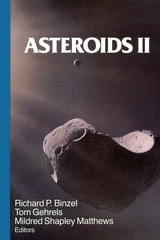
Asteroids II
Richard P. Binzel
University of Arizona Press, 1989
This sourcebook brought together our knowledge about asteroids, based on a gather during the week of March 8-11, 1988 with move than 160 scientists from 14 countries who gathered in Tucson for the Asteroids II conference.
Asteroids II is not a sequel, per se, to the 1979 book Asteroids. It offered a fresh treatment intended to stand on its own as a complete description of the current understanding of the field. It was published in December 1989. The work showcased a large international collaboration, a sign of an active and growing discipline.
Asteroids II is not a sequel, per se, to the 1979 book Asteroids. It offered a fresh treatment intended to stand on its own as a complete description of the current understanding of the field. It was published in December 1989. The work showcased a large international collaboration, a sign of an active and growing discipline.
[more]

Comets
Laurel L. Wilkening
University of Arizona Press, 1982
Over forty authorities present sections on the nucleus, dust, coma, and tails of comets, along with sections on their origin, and relationships to other solar system bodies. . . . An excellent book.—Space News
"The volume is highly recommended to all interested in comets and the Solar System."—Journal of the British Astronomical Association
"A good representation of the studies that are currently being done on comets, and it is an extremely good source of information on a wide variety of topics."—International Comet Quarterly
"Extremely well-written and informative. . . . A must for library collections."—The Observatory
"The volume is highly recommended to all interested in comets and the Solar System."—Journal of the British Astronomical Association
"A good representation of the studies that are currently being done on comets, and it is an extremely good source of information on a wide variety of topics."—International Comet Quarterly
"Extremely well-written and informative. . . . A must for library collections."—The Observatory
[more]
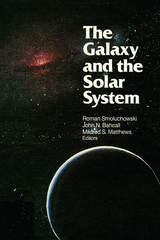
The Galaxy and the Solar System
Roman Smoluchowski
University of Arizona Press, 1986
Originally published in 1986, this work came out of a conference held in Tucson, Arizona in January 1985, which had the purpose of emphasizing the influence of the Galaxy on the solar system rather than to discuss the Galaxy and the solar system per se. The meeting was the first get-together of the galactic and solar system scientific communities. At the time, the conversations covered new and sometimes controversial topics. This work presented the latest research and stimulated new research and ideas.
[more]
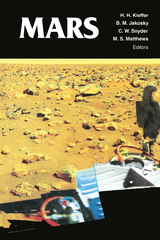
Mars
Edited by H. H. Kieffer, B. M. Jakosky, C. W. Snyder, and M. S. Matthews
University of Arizona Press, 1992
The planet Mars has been a subject of wonder for millennia, as attested by its place in mythology, by later speculation about its canals, and by the scientific and public excitement over the Viking mission. Although the scientific literature about the planet is voluminous, no comprehensive treatment of the results of modern spacecraft exploration has yet been made available. This volume fills that gap by providing a summary of what is presently known about Mars and identifying many puzzles such as polar cap variance, occurrence of dust storms, and the possible location of water. The introductory chapter cites questions, controversies, and milestones in the study of Mars, and also includes an annotated book list, basic data about the planet, and a guide to Martian seasons. A chapter on telescopic observation credits the contributions made by many amateurs that have advanced our knowledge of variations observed on Mars. A chapter on spacecraft exploration, by an American and a Russian author who have participated in all Mars missions, includes a revelation of an additional Soviet attempt. Twenty-nine technical articles cover geophysics; bedrock geology; surface; atmosphere; exosphere and magnetic field; and climate history. Two chapters address the search for life on Mars; three concluding chapters consider the Martian satellites. An indispensable reference for scientists, Mars will also serve as a complete sourcebook for serious amateur astronomers.
[more]
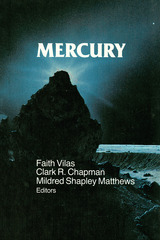
Mercury
Edited by Faith Vilas, Clark R. Chapman, and Mildred Shapley Matthews
University of Arizona Press, 1989
"At its best in synthesizing [current available] information to derive theories about the geological and tectonic histories of the planet ."—Science Books & Films
"This book is another in the excellent University of Arizona Space Science Series, each of which is based on a conference. . . .but goes far beyond a conference proceedings to present a comprehensive summary of current knowledge. . . .I recommend this book as a valuable compendium of current knowledge."—Pageoph
"This collection will be a most valuable addition to any research library."—Choice
"This book is another in the excellent University of Arizona Space Science Series, each of which is based on a conference. . . .but goes far beyond a conference proceedings to present a comprehensive summary of current knowledge. . . .I recommend this book as a valuable compendium of current knowledge."—Pageoph
"This collection will be a most valuable addition to any research library."—Choice
[more]
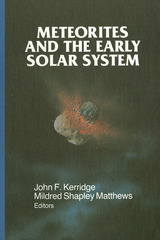
Meteorites and the Early Solar System
John F. Kerridge
University of Arizona Press, 1988
First published in November 1988, this work provided a coherent narrative about the known understandings of meteorites and the early solar system.
From the original publication:
From the original publication:
Although the Earth was formed, together with the other planets, at the birth of the solar system, geological activity has since erased all but a hint of the processes that accompanied its formation. If we wish to explore the processes that occurred in the earliest solar system, and the nature of the environment in which they took place, we must turn to the record contained in more primitive material. Many meteorites appear to satisfy that criterion, and much effort has been applied in identifying those meteorites, or their constituents, that have retained a reliable record of the early solar system. This book provides a synthesis of what has been learned so far about the earliest stages of solar system history through the study of meteorites, and what, given our current level of understanding, remains to be learned.
Contents 1. Introduction 2. Source Regions 3. Secondary Processing 4. Irradiation Effects 5. Solar System Chronology 6. Chondrites and the Early Solar System 7. Elemental Composition of Chondrites 8. Magnetic Fields in the Early Solar System 9. Chondrules10. Primitive Material Surviving in chondrites11. Micrometeorites12. Inhomogencity of the Nebula13. Survival of Presolar Material in Meteorites14. Nucleosynthesis15. Nucleocosmochronology16. Summary
Contents 1. Introduction 2. Source Regions 3. Secondary Processing 4. Irradiation Effects 5. Solar System Chronology 6. Chondrites and the Early Solar System 7. Elemental Composition of Chondrites 8. Magnetic Fields in the Early Solar System 9. Chondrules10. Primitive Material Surviving in chondrites11. Micrometeorites12. Inhomogencity of the Nebula13. Survival of Presolar Material in Meteorites14. Nucleosynthesis15. Nucleocosmochronology16. Summary
[more]
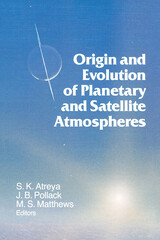
Origin and Evolution of Planetary and Satellite Atmospheres
Edited by S. K. Atreya, J. B. Pollack, and M.S. Matthews
University of Arizona Press, 1989
An integrated discussion of the similarities and differences between the atmospheres of various bodies of the solar system, including the Earth.
[more]
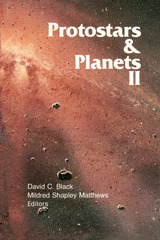
Protostars and Planets II
David C. Black
University of Arizona Press, 1985
Based on meetings held in Tucson, Arizona in 1984, this volume brought up-to-date recent advances and research on the cosmogony of stars and planets. This book presents the written thoughts of the principle speakers (and their colleagues) from the 1984 meeting. This work continued work started in 1978 to investigate the problems of star formation and the formation of the solar system.
[more]

Resources of Near-Earth Space
John S. Lewis
University of Arizona Press, 1993
Originally published in 1993
From the original publication:
A base on the Moon, an expedition to Mars. . . . Some time in the near future, for scientific or cultural reasons, humanity will likely decide to pursue one of these fantastic ventures in space. How can we increase the scope and reduce the cost of these ambitious activities?
The parts of the solar system that are most accessible from Earth—the Moon, the near-Earth asteroids, Mars and its moons—are rich in materials of great potential value to humanity. Resources of Near-Earth Space explores the possibilities both of utilizing these materials to produce propellants, structural metals, refractories, life-support fluids, and other materials on site to reduce the costs of space exploration, and of providing a source of materials and energy for our own planet that would not be environmentally destructive to Earth.This volume summarizes the present state of the art in attempts to realize these possibilities: identifying the resources, mining and processing, transportation, and economics. As a broad survey of a rapidly evolving field, it is intended as a technical introduction to the use of nonterrestrial materials for scientists, engineers, and industrial and governmental project managers who seek to make space more accessible.
The parts of the solar system that are most accessible from Earth—the Moon, the near-Earth asteroids, Mars and its moons—are rich in materials of great potential value to humanity. Resources of Near-Earth Space explores the possibilities both of utilizing these materials to produce propellants, structural metals, refractories, life-support fluids, and other materials on site to reduce the costs of space exploration, and of providing a source of materials and energy for our own planet that would not be environmentally destructive to Earth.This volume summarizes the present state of the art in attempts to realize these possibilities: identifying the resources, mining and processing, transportation, and economics. As a broad survey of a rapidly evolving field, it is intended as a technical introduction to the use of nonterrestrial materials for scientists, engineers, and industrial and governmental project managers who seek to make space more accessible.
[more]
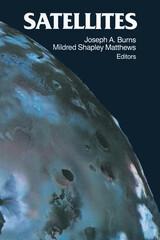
Satellites
Edited by Joseph A. Burns and Mildred Shapley Mathews
University of Arizona Press, 1986
"This is the 12th book in the University of Arizona Space Science Series, a burgeoning library destined to stand as the consummate literary legacy of our era's revolution in Solar System exploration. . . . Satellite science has matured rapidly since its rebirth in March 1979, and its vitality radiates from the pages of this fine volume."—Icarus
[more]
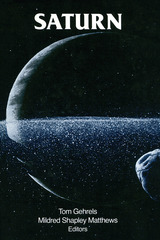
Saturn
Tom Gehrels
University of Arizona Press, 1984
Originally published in 1984
From the original publication:
The Saturn system is the most complex in the solar system, and this book is to summarize it all: the planet, rings, satellites, the magnetospheres, and the interaction with the interplanetary medium. The effective date of the material is approximately November 1983.
[more]
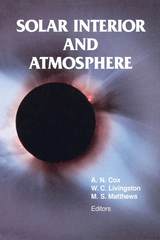
Solar Interior and Atmosphere
Edited by A. N. Cox, W. C. Livingston, and M. S. Matthews
University of Arizona Press, 1991
Observational data derived from the world’s largest solar telescopes are correlated with theoretical discussions in nuclear and atomic physics by contributors representing a wide range of interests in solar research.
[more]
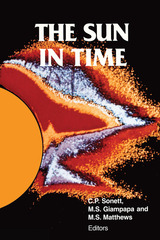
The Sun in Time
Edited by C. P. Sonett, M. S. Giampapa, and M. S. Matthews
University of Arizona Press, 1991
An interdisciplinary approach to solar physics, as eighty-nine contributors trace the evolution of the Sun and provide a review of our current understanding of both its structure and its role in the origin and evolution of the solar system.
[more]
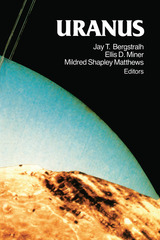
Uranus
Jay T. Bergstralh
University of Arizona Press, 1991
Uranus occupies a unique niche in the history of western thought; for while the planets from Mercury to Saturn had been known since pre-antiquity, Uranus was the first to be discovered, in 1781, through scientific investigation. Contemporary investigation of Uranus culminated in the Voyager 2 encounter in 1986. The results of that achievement, as well of concurrent research on the planet, are reviewed by 84 international authorities in this massive volume. Because Uranus' remoteness has prevented its being studied as intensively by earth-based observation as have other members of the solar system, most of what is known about the planet—its magnetic field and magnetosphere and satellites—were learned from the Voyager data, which is viewed here from a variety of perspectives. While the book is intended to serve as a comprehensive review, it also reports a substantial amount of original research results not previously published.
[more]
READERS
Browse our collection.
PUBLISHERS
See BiblioVault's publisher services.
STUDENT SERVICES
Files for college accessibility offices.
UChicago Accessibility Resources
home | accessibility | search | about | contact us
BiblioVault ® 2001 - 2024
The University of Chicago Press









